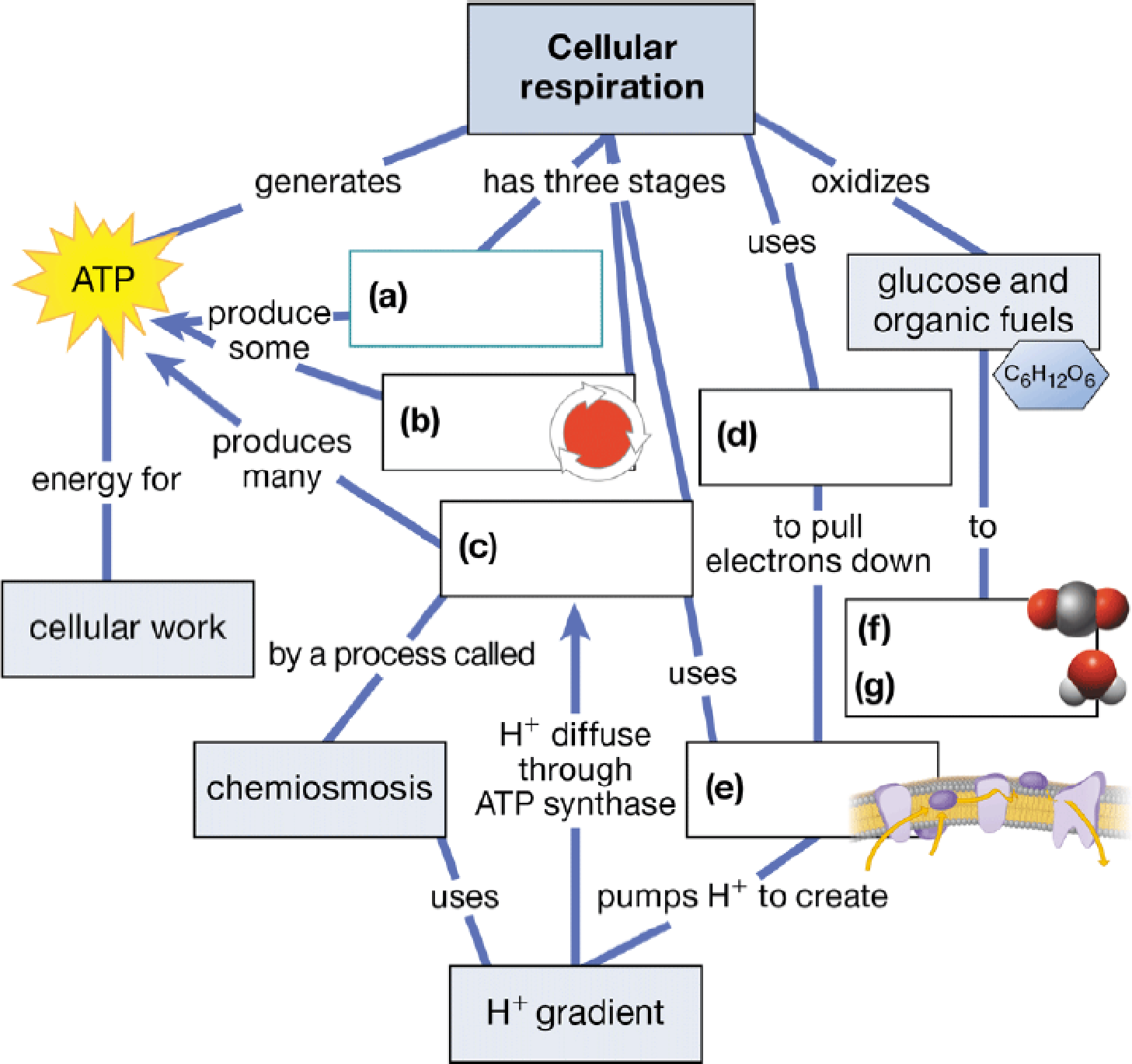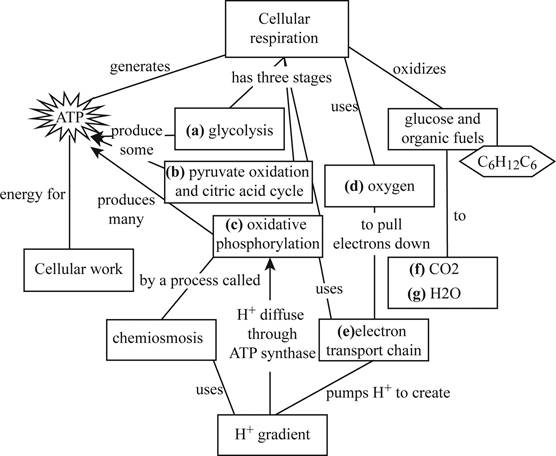
Concept explainers
Fill in the blanks in this summary map to help you review the key concepts of

To complete: The concept map to summarize the key concepts of cellular respiration.
Introduction:
The process of breathing and cellular respiration are closely associated. By breathing, an individual takes oxygen into the lungs and passes it to the blood. The blood carries the oxygen to cells where cellular respiration is carried out. Cellular respiration generates energy that is utilized for various cellular activities. There are several steps in cellular respiration; it includes glycolysis, pyruvate oxidation and citric acid cycle, and oxidative phosphorylation.
Answer to Problem 1CC
Pictorial representation: The Fig. 1 shows the vital concepts in cellular respiration.

Fig.1: Concepts map of cellular respiration.
Explanation of Solution
(a)
Correct answer: Glycolysis
Explanation:
Glycolysis is the first step of cellular respiration which occurs in the cytoplasm of the cell. The glycolysis process results in a breakdown of one glucose molecule into a three-carbon compound called pyruvate.
Hence, the correct answer is glycolysis.
(b)
Correct answer: Pyruvate oxidation and citric acid cycle
Explanation:
Pyruvate oxidation and the citric acid cycle are the second stage of the cellular respiration which takes place in the mitochondria. Here, pyruvate is oxidized into a two-carbon compound called acetyl Co-A. The citric acid cycle then completes the breakdown of glucose to carbon dioxide.
Hence, the correct answer is pyruvate oxidation and citric acid cycle.
(c)
Correct answer: Oxidative phosphorylation
Explanation:
Oxidative phosphorylation is the third stage of the cellular respiration. This involves electron transport and chemiosmosis. Oxidative phosphorylation is responsible for most of the ATP formation during the process of cellular respiration.
Hence, the correct answer is oxidative phosphorylation.
(d)
Correct answer: Oxygen
Explanation: Cellular respiration requires oxygen to trap the electrons in an electron transport chain. This helps in the generation of ATP by oxidative phosphorylation.
Hence, the correct answer is oxygen.
(e)
Correct answer: Electron transport chain
Explanation:
Electron transport chain is a series of an arranged molecular system in the mitochondrial cristae that passes the electrons to generate a proton potential across the inner mitochondrial membrane. This is required for oxidative phosphorylation and chemiosmosis.
Hence, the correct answer is electron transport chain.
(f)
Correct answer: CO2
Explanation:
Cellular respiration oxidizes the glucose and the organic fuels into carbon dioxide (CO2) and water molecules (H2O).
Hence, the correct answer is CO2.
(g)
Correct answer: H2O
Explanation:
Cellular respiration oxidizes the glucose and the organic fuels into carbon dioxide (CO2) and water molecules (H2O).
Hence, the correct answer is H2O.
Want to see more full solutions like this?
Chapter 6 Solutions
CAMPBEL BIOLOGY:CONCEPTS & CONNECTIONS
- P 200 150- 100 50 w/instrance/ w/insurance 2 100 Demand Assume that the white curve (labeled "Demand") represents an individual's true demand for this particular health care service. The coinsurance associated with insurance option 1 (in blue) is likely _. 0000 100% 25% 50% 0%arrow_forwardUse the figure below. Bob and Nancy have the same income and total utility.. willingness to pay for an insurance premium will be lower than because they are. risk- averse. Total utility Current utility Bob's utility Nancy's utility 0000 Bob; Nancy; less Nancy; Bob; less Nancy; Bob; more Bob; Nancy; more Current Income incomearrow_forwardConsider the figure below. Suppose the true price of a health care service is P1. Suppose further that the individual has obtained insurance that has a fixed copayment for this particular service. The copayment is represented by price P2. represents the quantity of the service the individual would consume without insurance. quantity of the service the individual would consume with the insurance. Health Care Service represents the P. P₂ a Q1;Q2 Q2; Q3 Q1; Q3 Q3; Q1 Q2; Q1 फ f Q ८ g d h Q3\D 7Q 00000arrow_forward
- The table shows the utility Jordan receives at various income levels, but they do not know what their income will be next year. There is a 15% chance their income will be $25,000, a 20% chance their income will be $35,000, and a 65% chance their income will be $45,000. We know that Jordan is Income $25,000 Utility 2,800 30,000 3,200 35,000 3,500 40,000 3,700 45,000 3,800 ☐ none of the above 0 000 risk taker (lover) because their marginal utility of income is increasing risk neutral because their marginal utility of income is constant risk averse because their marginal utility of income is decreasing risk neutral because their marginal utility of income is decreasingarrow_forwardOOOO a d+e d a+b+c Consider the figure below. Suppose the true price of a health care service is P1. Suppose further that the individual has obtained insurance that has a fixed copayment for this particular service. The copayment is represented by price P2. The social loss from moral hazard if the individual has copayment P2 is represented graphically by the area(s): Health Care Service P. a No 4 ८ e g Q2 Q3 Darrow_forwardOOO O The table shows the utility Jordan receives at various income levels, but they do not know what their income will be next year. There is a 15% chance their income will be $25,000, a 20% chance their income will be $35,000, and a 65% chance their income will be $45,000. We know that Jordan's expected income is. Their utility from their expected income is_ Income $25,000 Utility 2,800 30,000 3,200 35,000 3,500 40,000 3,700 45,000 3,800 $45,000; 3,800 $40,000; 3,700 $25,000; 2,800 $35,000; 3,500 $30,000; 3,200arrow_forward
- Question 1 Classify the Bird Mark 7; how is it: Powered Triggered Cycled Classify brid mark 7 Powered: By gas (oxygen) Triggered: Negative Pressure, caused by the patient’s inspiratory effort Cycled: The machine stops delivering gas and allows for exhalationarrow_forwardHypothetical "pedigree" for Sickle Cellarrow_forwardwould this be considered a novel protein and if not how can I fix it so it is and can you draw the corrections pleasearrow_forward
- In as much detail as possible, hand draw a schematic diagram of the hypothalamic-pituitary- gonad (HPG) axis in the human male. Be sure to include all the relevant structures and hormones. You must define all abbreviations the first time you use them. Please include (and explain) the feedback loops.arrow_forwardA negligence action was brought by a mother against a hospital on behalf of her minor daughter. It alleged that when the mother was 13 years of age, the hospital negligently transfused her with Rh-positive blood. The mother's Rh-negative blood was incompatible with and sensitized by the Rh-positive blood. The mother discovered her condition 8 years later during a routine blood screening ordered by her healthcare provider in the course of prenatal care. The resulting sensitization of the mother's blood allegedly caused damage to the fetus, resulting in physical defects and premature birth. Did a patient relationship with the transfusing hospital exist?arrow_forward18. Watch this short youtube video about SARS CoV-2 replication. SARS-CoV-2 Life Cycle (Summer 2020) - YouTube.19. What is the name of the receptor that SARS CoV-2 uses to enter cells? Which human cells express this receptor? 20. Name a few of the proteins that the SARS CoV-2 mRNA codes for. 21. What is the role of the golgi apparatus related to SARS CoV-2arrow_forward

 Biology Today and Tomorrow without Physiology (Mi...BiologyISBN:9781305117396Author:Cecie Starr, Christine Evers, Lisa StarrPublisher:Cengage Learning
Biology Today and Tomorrow without Physiology (Mi...BiologyISBN:9781305117396Author:Cecie Starr, Christine Evers, Lisa StarrPublisher:Cengage Learning Human Physiology: From Cells to Systems (MindTap ...BiologyISBN:9781285866932Author:Lauralee SherwoodPublisher:Cengage Learning
Human Physiology: From Cells to Systems (MindTap ...BiologyISBN:9781285866932Author:Lauralee SherwoodPublisher:Cengage Learning Biology: The Dynamic Science (MindTap Course List)BiologyISBN:9781305389892Author:Peter J. Russell, Paul E. Hertz, Beverly McMillanPublisher:Cengage Learning
Biology: The Dynamic Science (MindTap Course List)BiologyISBN:9781305389892Author:Peter J. Russell, Paul E. Hertz, Beverly McMillanPublisher:Cengage Learning Human Biology (MindTap Course List)BiologyISBN:9781305112100Author:Cecie Starr, Beverly McMillanPublisher:Cengage Learning
Human Biology (MindTap Course List)BiologyISBN:9781305112100Author:Cecie Starr, Beverly McMillanPublisher:Cengage Learning Concepts of BiologyBiologyISBN:9781938168116Author:Samantha Fowler, Rebecca Roush, James WisePublisher:OpenStax College
Concepts of BiologyBiologyISBN:9781938168116Author:Samantha Fowler, Rebecca Roush, James WisePublisher:OpenStax College





